Comments / Questions (31)
![]() Anke wrote:
Anke wrote:
Hallo, wie verstehe ich die Abnahmen im Diagramm M4 richtig? Und wie gleiche ich die durch die Abnahme entstehenden eingerückten Reihen dann später bei der Blend wieder aus? Gruß Anke
27.01.2020 - 22:26DROPS Design answered:
Liebe Anke, M.4 lesen Sie von unten nach oben. Wenn Sie das Symbol für die Abnahme sehen, dann stricken Sie 2 Maschen zusammen (entweder am Anfang oder am Ende M.4). Diese Abnahmen wiederholen Sie in jedem M.4 (= 1 Masche pro M.4 abgenommen = M.4 wird 15 Mal in der Reihe wiederholt), so daß Sie nach und nach weniger Maschen auf der Nadel haben (dh Sie nehmen 15 Maschen pro Abnahmenreihe ab). Die restlichen 83 Maschen sind dann für die Halskante (nach den Blenden von den Vorderteilen) gestrickt. Viel Spaß beim stricken!
28.01.2020 - 10:41
![]() Anke wrote:
Anke wrote:
Hallo nochmal, ich habe im Diagramm jetzt gesehen, dass ich 2 Maschen zusammenstricken. Insgesamt sind das dann aber 20 Maschen und ich habe dann immer noch 223 Maschen statt 93. Wie muss ich die Abnahmen machen?
24.01.2020 - 18:53DROPS Design answered:
Liebe Anke, siehe Antwort unten :)
27.01.2020 - 07:48
![]() Anke wrote:
Anke wrote:
Hallo, ich stricke die Jacke in Größe 5/6. Bei der Passe habe ich zu Beginn von M4 243 Maschen auf der Nadel. Warum sind es dann am Ende nur noch 93 Maschen? In der Anleitung finde ich keinen Hinweis zur Abnahme. Im Muster von M4 sind die Reihen teilweise eingerückt, ich weiß aber nicht was ihr damit meint und wie ich die Maschen dann anscheinend während des Musters M4 abnehmen muss. Könnt ihr mir das bitte genau erklären!? Gruß Anke
24.01.2020 - 18:49DROPS Design answered:
Liebe Anke, bei der Passe stricken Sie Diagram M.4 (= 16 Maschen) über die 243 M, dh so: 1 Randmasche, wiederholen Sie jetzt 15 Mal die 16 Maschen vom Diagram, stricken Sie dann die erste Masche, 1 Randmaschen. Es werden in M.4 abegnommen (siehe letzte Symbol) insgesamt 10 Mal = 6 M bleiben in jedem M.4 x 15 + die erste Masche + 2 Randmaschen = 93 Maschen. Viel Spaß beim stricken!
27.01.2020 - 07:48Janis wrote:
I would like to make this cardigan in a machine washable yarn. Can you recommend a substitute please? Thanks.
20.05.2018 - 11:32DROPS Design answered:
Dear Janis, you could use any superwash yarn group A>/a> - eg DROPS Fabel , Delight or Baby Merino. Read more here about alternative and use our yarn converter. Happy knitting!
22.05.2018 - 08:40
![]() Mia Merethe Bye wrote:
Mia Merethe Bye wrote:
Stemmer det at ermene i str 3/4år skal være 27 cm før felling midt under erme. (på tegningen viser det 23)synes det virker så langt.
14.03.2018 - 09:14DROPS Design answered:
Hej Mia, ja det stemmer, du har 4 cm rib + 23 cm glatstrik ialt 27 cm ærme. God fornøjelse!
14.03.2018 - 15:40
![]() Josephine Shelton wrote:
Josephine Shelton wrote:
I don’t understand the instructions for the yoke. Can I get an easier explanation. I have done lots of faire Isle but this is baffling me!
01.11.2017 - 23:53DROPS Design answered:
Dear Mrs Shelton, purl first a row from WS over all sts dec some sts evenly in some size. Then work 0-2-6-10 rows with off-white. Now work diagram: 1 edge st in garter st, repeat M.4 in width (starting on the bottom corner on the right side and read from right to left from RS and from left to right from WS) until 2 sts remain on needle, work the 1st st in A.4 (so that pattern is symetrical on both front piece, but when dec in M.4 do not dec these st, just work it with the color stated) and finish with 1 st in garter st. Happy knitting!
02.11.2017 - 09:24
![]() Birthe Nyborg wrote:
Birthe Nyborg wrote:
Bærestykket bliver alt for stort i Jolie Fleur! Hvad har jeg gjort forkert? Det er som om, det skulle have været strikket rundt og ikke frem og tilbage? Størrelse 5/6.
17.09.2016 - 11:42DROPS Design answered:
Hej Birthe. Har du den rette strikkefasthed, saa burde det vaere i orden. Du har 251 masker naar du har sat alle ind paa rundpinden = forstk+aerme+rygstk+forstk. Med den rette strikkefasthed (24 m) har du en omkreds - hen over skuldrene paa ca. 104-105 cm. For for/rygstk har du ca. 73 cm / 2 =36 cm per del (fladt maalt inden du saetter aermerne ind)
28.09.2016 - 14:09
![]() Ida Goedhart wrote:
Ida Goedhart wrote:
Hoe kom ik bij het breien van de pas van 243 naar 93 steken? ik brei telpatroon M.4 maar begrijp niet waar en hoe ik moet minderen
21.10.2015 - 22:45DROPS Design answered:
Hoi Ida. Bij het breien van M.4 minder je ook (zie bijvoorbeeld rij 15 en 17 in het telpatroon).
22.10.2015 - 12:05
![]() Janeche wrote:
Janeche wrote:
Hei, Jeg strikker str. 110/116. Når jeg har strikket M4 ferdig har jeg 115 masker igjen, ikke 105 som det står i oppskriften. Jeg har felt på riktig antall pinner og det har hele tiden gått opp med mønstret så jeg antar det er gjort rett. Kan det være feil i oppskriften?
07.07.2015 - 09:49DROPS Design answered:
Ifølge opskriften skal du kun have 93 m tilbage i den størrelse. Du har 243 m, strikker diagrammet 15 gange rundt på omgangen og tager 10 m ind i hvert diagram 15x10=150 m. = 243-150=93 m tilbage. Held og lykke!
08.07.2015 - 15:07
![]() Monika Wanzelius wrote:
Monika Wanzelius wrote:
Smådrops 22-4. Fram-och bakst: Rad 8 - Fortsätt så tills Arb mäter 20-23-25-27-29. Stämmer det? Eller ska det vara 35-38-41-47?
21.04.2015 - 11:36DROPS Design answered:
Hej Monika. Ja, det stemmer. Herefter skal du strikke ermer og öket som saa til slut bliver 35-38-41-47 total höjde.
21.04.2015 - 13:16
Jolie Fleur#joliefleurcardigan |
|||||||||||||||||||||||||
|
|
|||||||||||||||||||||||||
Knitted cardigan with round yoke and multi-coloured pattern in DROPS Alpaca. Size children 3 to 12 years.
DROPS Children 22-4 |
|||||||||||||||||||||||||
|
GARTER ST (back and forth on needle): K all rows. PATTERN: See diagram M.1 to M.4. All diagrams are worked in stocking st. NOTE: When working diagram M.2, pull up the pattern thread to next row when working dots. Do not cut the thread because the thread fastening might shine through. -------------------------------------------------------- BODY: Worked back and forth on circular needle from mid front. Cast on 164-176-192-208-220 sts (incl 1 edge st in each side towards mid front) on circular needle size 2.5 mm with off white. P 1 row from WS. Then work rib as follows (seen from RS): 1 edge st in GARTER ST - see explanation above, * K 2, P 2 *, repeat from *-*, finish with K 2 and 1 edge st in garter st. When rib measures approx. 4 cm (adjust so that next row is worked from RS), switch to circular needle size 3 mm. K 1 row while AT THE SAME TIME dec 25-25-29-33-33 sts evenly = 139-151-163-175-187 sts. Work 3 rows in stocking st. Continue to work as follows: 1 edge st in garter st, diagram M.1A until 6 sts remain, diagram M.1B and 1 edge st in garter st. When diagram M.1 has been worked 1 time vertically, work 3 rows in stocking st with off white. Continue as follows (from RS): 1 edge st, diagram M.2A until 6 sts remain, diagram M.2B and 1 edge st. Continue working like this until piece measures approx. 20-23-25-27-29 cm (adjust so that 3 rows with one colour have been worked after 1 row with dots). REMEMBER THE KNITTING TENSION! Work next row as follows with off white: Work 32-35-38-41-44 sts, cast off 6 sts for armhole, work 63-69-75-81-87 sts, cast off 6 sts for armhole, work the rest of row (= 32-35-38-41-44 sts). Put piece aside and work the sleeves. SLEEVE: Worked in the round on double pointed needles. Cast on 52-56-60-60-64 sts on double pointed needles size 2.5 mm with off white. K 1 round. Continue in rib = K 2/P 2 for 4 cm. Switch to double pointed needles size 3 mm. K 1 round while AT THE SAME TIME dec 8-10-12-10-12 sts evenly = 44-46-48-50-52 sts. K 2 rounds. Then work diagram M.3 one time vertically, then K 1 round with off white. Insert a marker at beg of round = mid under sleeve. Continue as follows: 4-5-0-1-2 sts in off white, diagram M.2A over 36-36-48-48-48 sts, 4-5-0-1-2 sts with off white. AT THE SAME TIME when piece measures 8-8-8-8-9 cm, inc 1 st on each side of marker. Repeat inc every 7th-9th-9th-9th-9th round a total of 8-8-10-11-12 times = 60-62-68-72-76 sts. Work the inc sts gradually in diagram M.2A. When piece measures approx. 27-32-36-39-43 cm (adjust so that 3 rounds with one colour have been worked after 1 round with pattern), work 1 round with off white while at the same time casting off 6 sts mid under sleeve (i.e. 3 sts on each side of marker) = 54-56-62-66-70 sts remain on needle. Put piece aside and knit another sleeve. YOKE: Slip sleeves on to same circular needle as body where armholes were cast off = 235-251-275-295-315 sts. P 1 row from WS with off white while AT THE SAME TIME dec 8-8-0-4-8 sts evenly = 227-243-275-291-307 sts. Work 0-0-2-6-10 more rows with off white back and forth. Continue to work as follows: 1 edge st in garter st, diagram M.4 until 2 sts remain, work the first st as the first st in diagram M.4 (so that the pattern is the same on each side of mid front), then 1 edge st in garter st. When diagram M.4 has been worked vertically, 87-93-105-111-117 sts remain on needle. K 1 row from RS with off white while AT THE SAME TIME casting off 1 edge st in each side and while at the same time dec 17-19-27-27-29 sts evenly = 68-72-76-82-86 sts, cut the thread. Slip the sts on a stitch holder. LEFT BAND: Worked back and forth on circular needle. Knit up on circular needle size 2.5 mm with off white, approx. 90 to 120 sts inside 1 edge st along left front piece. K 1 row from WS while at the same time adjusting no of sts to 109-117-125-133-141. Then work rib as follows (from the top, seen from RS): 1 st in garter st, * K 2, P 2 *, repeat from *-* until 4 sts remain which are worked K 2 and 2 sts in garter st. Continue like this until rib measures approx. 2.5 cm. Loosely cast off with K over K and P over P. RIGHT BAND: Work as left band – AT THE SAME TIME when band measures approx. 1.5 cm, cast off for 7-7-7-8-8 button holes evenly. 1 BUTTON HOLE = cast off 2 P sts and cast on 2 new sts on next row over these sts. Upper button hole should be in first P-section. Bottom hole should be approx. 2 cm from bottom edge. NECK EDGE: Worked back and forth on circular needle. Knit up on circular needle size 2.5 mm with off white (from RS) as follows: 6 sts at the top along band on right front piece (inside 1 st in garter st), then work the sts from body on the needle = 68-72-76-82-86 sts and knit up 6 sts at the top along band on left front piece = 80-84-90-94-98 sts. Then work an elevation at the back as follows in garter st: K 45-47-50-52-54 sts, turn, K 10 sts, turn, K 20 sts, turn, continue to work 10 sts more on every turn until a total of 50-50-70-70-70 sts have been worked (= 3-3-4-4-4 ridges (1 ridge = 2 rows), turn and work the rest of row. Work 1 row over all sts before casting off. ASSEMBLY: Sew the openings under the sleeves tog. Sew on buttons. |
|||||||||||||||||||||||||
Diagram explanations |
|||||||||||||||||||||||||
|
|||||||||||||||||||||||||
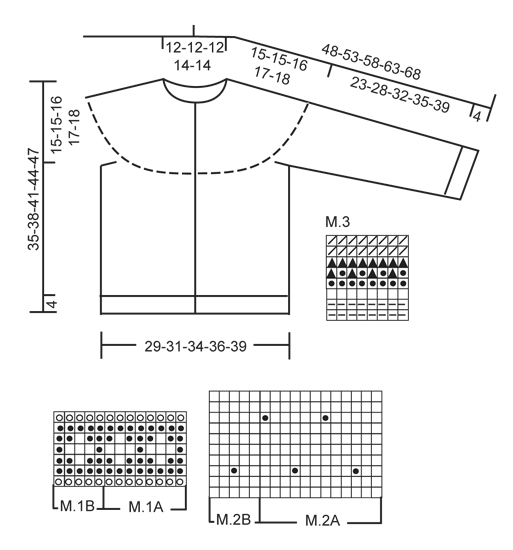 |
|||||||||||||||||||||||||
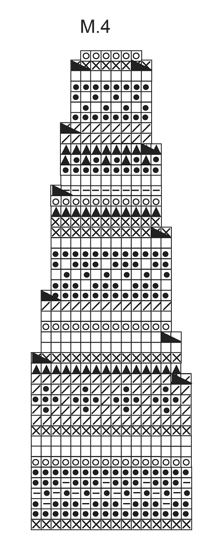 |
|||||||||||||||||||||||||
Have you finished this pattern?Tag your pictures with #dropspattern #joliefleurcardigan or submit them to the #dropsfan gallery. Do you need help with this pattern?You'll find 18 tutorial videos, a Comments/Questions area and more by visiting the pattern on garnstudio.com. © 1982-2025 DROPS Design A/S. We reserve all rights. This document, including all its sub-sections, has copyrights. Read more about what you can do with our patterns at the bottom of each pattern on our site. |
|||||||||||||||||||||||||











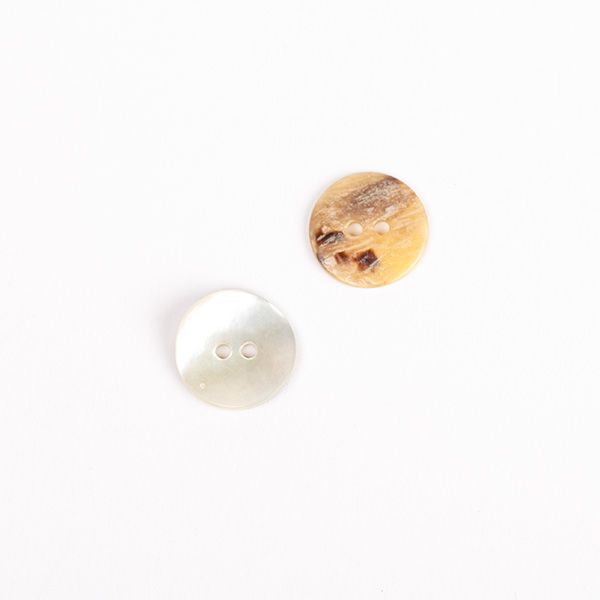




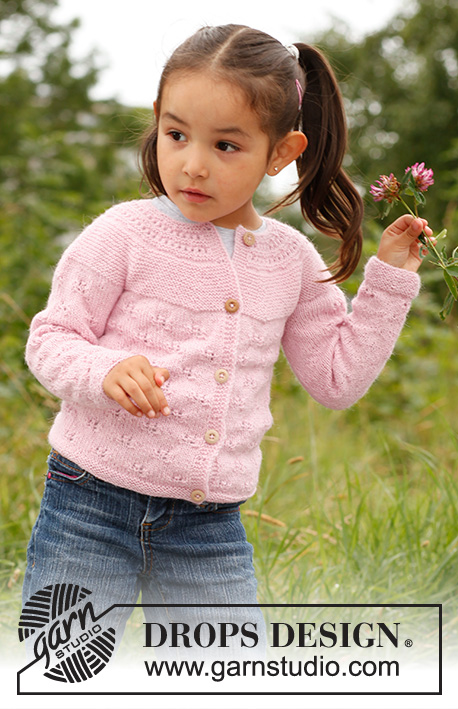
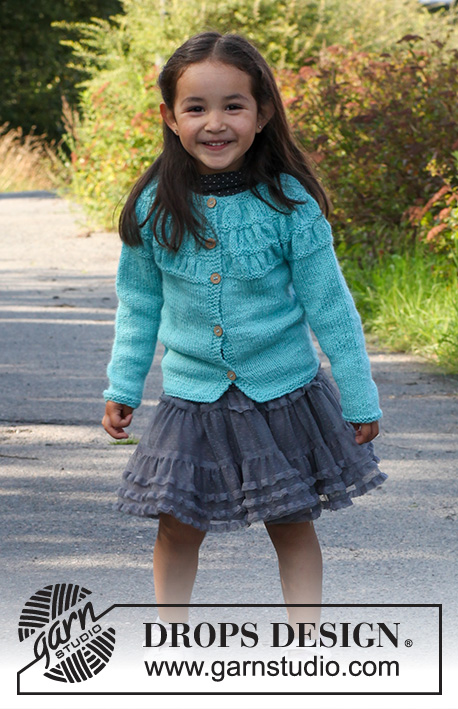














































Post a comment to pattern DROPS Children 22-4
We would love to hear what you have to say about this pattern!
If you want to leave a question, please make sure you select the correct category in the form below, to speed up the answering process. Required fields are marked *.